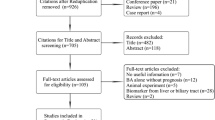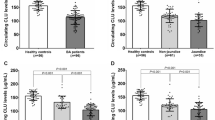Abstract
Biliary atresia (BA) remains one of the most intractable liver diseases in children. The aim of this study was to investigate the possible roles of nitric oxide (NO) in BA. Serum levels of nitrite and nitrate (NO production) were determined using a colorimetric method from 65 post-operative BA patients and 12 healthy children. The patients were categorized into two groups according to their jaundice status, and serum alanine aminotransferase (ALT, a marker for liver injury). Unpaired t tests were used. Data are expressed as mean and SD in terms of μmol/l. Age and gender between BA patients and controls were comparable. Serum NO metabolites of BA patients was higher than the controls (79.77±21.22 vs. 65.75±9.44, P=0.001). Subgroup analysis revealed that there was no difference in serum nitrate/nitrite levels of BA patients without jaundice compared to those with jaundice (78.85±23.23 vs. 80.90±18.76, P=0.70). However, patients with serum ALT≥100 IU/l had higher levels of serum NO metabolites compared to those with serum ALT<100 IU/l. In conclusion, NO production was elevated in BA patients compared to normal controls. Serum NO was associated with serum ALT levels, but not with jaundice status, in BA patients. These suggest that NO plays a role in the pathophysiology of liver injury in post-operative BA.
Similar content being viewed by others
References
Ohi R (2001) Surgery for biliary atresia. Liver 21:175–182
Kobayashi H (2003) Biliary atresia. Semin Neonatol 8:383–391
Chongsrisawat V, Ampai S, Chottivittayatarakorn P, Sirisopikul T, Poovorawan Y (2003) Relationship between vasoactive intestinal peptide and intrapulmonary vascular dilatation in children with various liver diseases. Acta Paediatr 92:1411–1414
Chongsrisawat V, Chatchatee P, Samransamruajkit R, Vanapongtipagorn P, Chottivittayatarakorn P, Poovorawan Y (2003) Plasma endothelin-1 levels in patients with biliary atresia: possible role in development of portal hypertension. Pediatr Surg Int 19:478–481
Kobayashi H, Li Z-X, Yamataka A, Lane GJ, Miyano T (2002) Clinical evaluation of serum levels of matrix metalloproteinases and tissue inhibitors of metalloproteinases as predictors of progressive fibrosis in postoperative biliary atresia patients. J Pediatr Surg 37:1030–1033
Yoshida S, Nio M, Hayashi Y, Ohi R, Kawamura I, Goto T (2003) Serum insulinlike growth factor-I in biliary atresia. J Pediatr Surg 38:211–215
Chongsrisawat V, Kongtawelert P, Tongsoongnoen W, Tangkijvanich P, Vejchapipat P, Poovorawan Y (2004) Serum hyaluronan as a marker reflecting the severity of cirrhosis and portal hypertension in postoperative biliary atresia. Pediatr Surg Int 20:773–777
Liu C, Chiu J-H, Chin T, Wang L-S, Li AF-Y, Chow K-C, Wei C (2000) Expression of Fas ligand on bile ductile epithelium in biliary atresia—a poor prognostic factor. J Pediatr Surg 35:1591–1596
Battista S, Bar F, Mengozzi G, Pollet C, Torchio M, Cavalli G, Rosina F, David E, Cutrin JC, Cavaleri B, Poli G, Molino G (2001) Evidence of an increased nitric oxide production in primary biliary cirrhosis. Am J Gastroenterol 96:869–875
Hokari A, Zeniya M, Esumi H, Kawabe T, Gershwin ME, Toda G (2002) Detection of serum nitrite and nitrate in primary biliary cirrhosis: possible role of nitric oxide in bile duct injury. J Gastroenterol Hepatol 17:308–315
Balistreri WF, Grand R, Hoofnagle JH, Suchy FJ, Ryckman FC, Perlmutter DH, Sokol RJ (1996) Biliary atresia: current concepts and research directions. Hepatology 23:1682–1692
Vejchapipat P, Theamboonlers A, Chaokhonchai R, Chongsrisawat V, Chittmittrapap S, Poovorawan Y (2004) Serum hepatocyte growth factor and clinical outcome in biliary atresia. J Pediatr Surg 39:1045–1049
Beckman JS, Koppenol WH (1996) Nitric oxide, superoxide and peroxynitrite: the good, the bad, and the ugly. Am J Physiol 271:C1424–C1437
Clemens MG (1999) Nitric oxide in liver injury. Hepatology 30:1–5
Nadler EP, Upperman JS, Dickinson EC, Ford HR (1999) Nitric oxide and intestinal barrier failure. J Pediatr Surg 8:148–154
Balakirev MY, Khramtsov VV, Zimmer G (1997) Modulation of the mitochondrial permeability transition by nitric oxide. Eur J Biochem 246:710–718
Szabo C (1996) DNA strand breakage and activation of poly-ADP ribosyltransferase: a cytotoxic pathway triggered by peroxynitrite. Free Radic Biol Med 21:855–869
Szabo C, Ohshima H (1997) DNA damage induced by peroxynitrite: subsequent biological effects. Nitric Oxide 1:373–385
Coskun U, Ozenirler S, Sancak B, Bukan N (2001) Serum and ascitic fluid nitrate levels in patients with cirrhosis. Clin Chim Acta 306:127–132
Mohammed NA, Abd El-Aleem S, Appleton I, Maklouf MM, Said M, McMahon RF (2003) Expression of nitric oxide synthase isoforms in human liver cirrhosis. J Pathol 200:647–655
Sierra M, Gonzalez A, Gomez-Alamillo C, Monreal I, Huarte E, Gil A, Sanchez-Casajus A, Diez J (1998) Decreased excretion of nitrate and nitrite in essential hypertensives with renal vasoconstriction. Kidney Int Suppl 68:S10–S13
Acknowledgments
We are grateful to the Thailand Research Fund and Center of Excellence of Thailand for their generous support. Also, we would like to express our gratitude to the entire staff of the Viral Hepatitis Research Unit, Chulalongkorn University and Hospital for their efforts in the present study. This project was supported by Rachadaphisek Somphot Fund, Faculty of Medicine, Chulalongkorn University, Thailand.
Author information
Authors and Affiliations
Corresponding author
Rights and permissions
About this article
Cite this article
Vejchapipat, P., Chongsrisawat, V., Theamboonlers, A. et al. Elevated serum nitric oxide metabolites in biliary atresia. Ped Surgery Int 22, 106–109 (2006). https://doi.org/10.1007/s00383-005-1581-8
Published:
Issue Date:
DOI: https://doi.org/10.1007/s00383-005-1581-8




